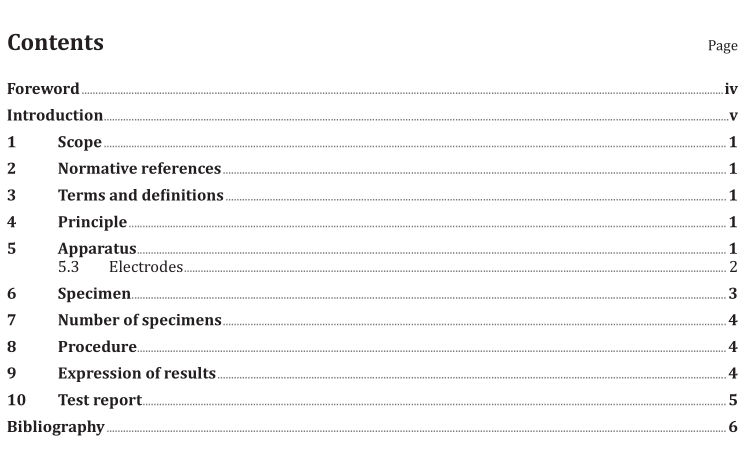BS EN ISO 3915 pdf download

BS EN ISO 3915 pdf download Plastics — Measurement of resistivity of conductive plastics
1 Scope
This document specifies the requirements for the laboratory testing of the resistivity of speciallyprepared specimens of plastics rendered conductive by the inclusion of conductive fillers orsuitable modification of the structure. The test is applicable to materials of resistivity less than106 Q-cm ( 104 Q-m).
The result is not strictly a volume resistivity, because of surface conduction, but the effects of the latterare generally negligible.
2Normative references
There are no normative references in this document.
Terms and definitions
No terms and definitions are listed in this document.
IS0 and IEC maintain terminological databases for use in standardization at the following addresses:- ISo online browsing platform: available at https://www.iso.org/obp
-IEC Electropedia: available at https://www.electropedia.org/
4Principle
The principle of the four-terminal method of test is mandatory and the recommended specimen sizeand electrode design shall be adhered to for reference purposes, but it can sometimes be necessary totest a wider strip with electrodes of a different construction.
A stable direct current of magnitude (I) is passed between electrodes at the two ends of a strip of thematerial under test. The voltage drop (AU) between two potential electrodes is measured with anelectrometer. The resistance of the portion of the strip between the potential electrodes is given byR = AU/l, and is independent of contact resistances.Thus, the resistivity can be calculated.
5 Apparatus
See Figure 1 for schematic diagram of test circuit.
5.4 Electrometer, havingan input resistance greaterthan 1011 Qand measuring to an accuracy of±5%.5.5Sheet of highly insulating material, having a volume resistivity greater than 1015 Q-cm.
5.6Oven, capable of being maintained at a temperature of (70±2) °C, or (60 ± 2)°C, if required.
6Specimen
The specimen shall be a strip of preferably 10 mm width.Higher widths may be used as long as theydo not exceed the width of the potentiometric electrodes (see 5.3.2). The specimen shall be 70 mm to150 mm long and shall normally be 3 mm to 4 mm thick with a tolerance on uniformity of thickness of±5%.Thicker or thinner specimens may be cut from sheets or products.Care shall be taken to avoidbending or stretching the sheets or specimens, especially when they are thinner than standard.
The specimen may be cut with a knife or razor blade, but care shall be taken to minimize distortion asthis can affect the resistance values.
The surfaces of the specimen shall be clean; if necessary, they may be cleaned by rubbing with fuller’searth (hydrated magnesium-aluminium silicate) and water, rinsing with distilled water and allowing todry.1) The surfaces shall neither be buffed nor abraded, nor shall they be cleaned with organic materialsthat attack or swell the material.
7Number of specimens
From each of two perpendicular directions, three specimens of equal size shall be prepared and tested.The two directions should, where possible, be chosen to be along and across any direction of flowduring processing.
8Procedure
8.1 After preparation,allow the specimen to remain at room temperature and ambient humidityconditions for at least 16 h.
8.2 Prior to the commencement of the test, connect the current electrodes (5.3.1) to the ends of thespecimen,either by using the clamps or grips, or by covering the same area with conductive paint.
8.3The required conditioning of the specimen should be described in the material specification.If thisis not the case, the following procedure can be used: lmmediately after applying the current electrodes,place the specimen on the sheet of highly insulating material (5.5) and heat in the oven (5.6) for 2 h at atemperature of (70± 2)°C to remove strains and irregularities caused by previous treatment.Cool for atleast 1 h and test at (23 ±2) °C and(50 ±5)% relative humidity without disturbing the specimen.Thespecimen shall always be tested on the sheet of insulating material. With some materials, distortion canoccur at 70 C and heating for 5 h at (60± 2) C can then be preferable.
8.4 Place the potentiometric electrode system(5.3.2) on the specimen, ensuring that the knife-edgecontacts are at right angles to the direction of current flow and that neither potentiometric electrodeis within 20 mm of a current electrode.Apply the current and measure the voltage drop between thepotentiometric electrodes using the electrometer (5.4).
Repeat the measuring procedure twice more on the same specimen,moving the potentiometricelectrodes each time to obtain measurements over lengths of specimen evenly distributed between thecurrent electrodes.
8.5Test the other five specimens similarly.









